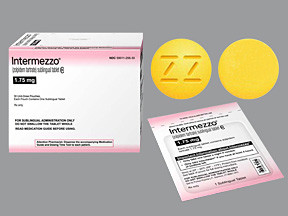ZOLPIDEM (1.75 OR 3.5 MG) - SUBLINGUAL
PHONETIC PRONUNCIATION: (ZOL-pi-dem)
COMMON BRAND NAME(S): Intermezzo
GENERIC NAME(S): zolpidem tartrate
Uses
USES: This medication is used to treat a certain type of sleep problem (insomnia) in adults who have trouble falling back asleep after waking up in the middle of the night. It helps you return to sleep faster so you can get a better night's rest. Zolpidem belongs to a class of drugs called sedative-hypnotics. It acts on your brain to produce a calming effect. This medication should only be taken if you have at least 4 hours of bedtime left. Zolpidem is usually limited to short treatment periods of 1 to 2 weeks or less.
How to use ZOLPIDEM (1.75 OR 3.5 MG) - SUBLINGUAL
HOW TO USE: Read the Medication Guide and the Instructions for Use provided by your pharmacist before you start taking zolpidem and each time you get a refill. If you have any questions, ask your doctor or pharmacist. If you wake up in the middle of the night and have trouble falling asleep again, take this medication as directed by your doctor, usually only once a night if needed. Only take it if you have at least 4 hours of bedtime left, otherwise you may still be drowsy in the morning. Do not take this medication with alcohol, or if you have had alcohol that day, especially in the evening or before bed. Also do not take this medication with other drugs to help you sleep. Do not remove the medication from the pouch until you are ready to take it. Since zolpidem works quickly, take it while you are in bed. It is best to take it on an empty stomach. Do not take zolpidem with or after a meal because it will not work as quickly. Place the tablet under your tongue and let it break apart completely before swallowing. Do not swallow the tablet whole. The dosage is based on your gender, age, medical condition, response to treatment, and other medications you may be taking. Women are usually prescribed a lower dose because it is removed from the body more slowly than in men. Older adults are usually prescribed a lower dose to decrease the risk of side effects. Do not increase your dose, take it more often, or use it for longer than prescribed. Be sure to tell your doctor and pharmacist about all the products you use (including prescription drugs, nonprescription drugs, and herbal products). This medication may cause withdrawal reactions, especially if it has been used regularly for a long time or in high doses. In such cases, withdrawal symptoms (such as nausea, vomiting, flushing, stomach cramps, nervousness, shakiness) may occur if you suddenly stop using this medication. To prevent withdrawal reactions, your doctor may reduce your dose gradually. Consult your doctor or pharmacist for more details, and report any withdrawal reactions right away. When this medication is used for a long time, it may not work as well. Talk with your doctor if this medication stops working well. Though it helps many people, this medication may sometimes cause addiction. This risk may be higher if you have a substance use disorder (such as overuse of or addiction to drugs/alcohol). Take this medication exactly as prescribed to lower the risk of addiction. Ask your doctor or pharmacist for more details. Tell your doctor if your condition persists after 7 to 10 days, or if it worsens. You may have trouble sleeping the first few nights after you stop taking this medication. This is called rebound insomnia and is normal. It will usually go away after 1-2 nights. If this effect continues, contact your doctor.
Side Effects
Precautions
Interactions
Overdose
Images
Reviews
Disclaimer
IMPORTANT: HOW TO USE THIS INFORMATION: This is a summary and does NOT have all possible information about this product. This information does not assure that this product is safe, effective, or appropriate for you. This information is not individual medical advice and does not substitute for the advice of your health care professional. Always ask your health care professional for complete information about this product and your specific health needs.




No Reviews Yet